This cache is NOT at posted-coordinates.
DO NOT go INSIDE the building looking for this cache.
The puzzle is designed to give you some history about a very
important part of Detroit's Entertainment past...and hopefully future.
You must sign the log to claim the find. Thank you!
This cache is a "sister" cache to:
GC45W7G - Come Dancing: The Vanity Ballroom
"...Come dancing
Come on, sister
Have yourself a ball
Don't be afraid
To come dancing
It's only natural
Come dancing
Just like the palais on a Saturday
And all her friends will come dancing
Where the big band used to play..."
- Excerpt from the lyrics to "Come Dancing"
by the Kinks (US release 1983)
The Grande Ballroom
Open: 1928 - Closed: 1972

September 1928 view of the Grande Ballroom
In the 1920s, six extraordinary ballrooms were built in Detroit--the Graystone, the Grande, the Jefferson Beach, the Mirror, the Monticello and the Vanity. Patrons went to these spectacular ballrooms to socialize, dance, listen to various performers and bands over the many years that these ballrooms were open.
There was an ongoing contest between architects to create flashy and innovative ballrooms for the public to enjoy. Aztec and Totec motifs were often used which made patrons feel that they were entering a fantasy world within these well-designed and fantastic-decor venues.

Blueprint drawings by Charles Agree (1928)
The Grande ballroom started off in the late-1920's as a place for Detroiters to dance, listen to Jazz and the Big Bands of the era, and just "hang out" with folks that loved to dance and have a good time. In the late 1960's and early 1970's, it would gain "immortal" status in the legends of the music industry as it would evolve into a Rock & Roll venue with the likes of the MC5 and the Stooges playing their punk and hard-driving sounds.
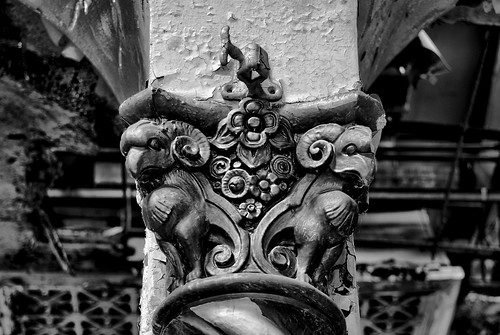 Architectural details of the Grande Ballroom (recent photo)
Architectural details of the Grande Ballroom (recent photo)
The Grande's roots were musical, and it's walls echoed the sounds of the times. Those that performed there cut their chops and many became legends.
 Roof blueprints of the Grande, 1928
Roof blueprints of the Grande, 1928 The Grande had shops on the first floor, and dancing on the second. December 12, 1944 Photo
The Grande had shops on the first floor, and dancing on the second. December 12, 1944 Photo Polished and spacious floors awaited and welcomed dancers to the Vanity Ballroom. Similar floor was installed at the Grande.
Polished and spacious floors awaited and welcomed dancers to the Vanity Ballroom. Similar floor was installed at the Grande.
After the war, styles and tastes in entertainment began to change and dance halls attempted to keep up and change with the times, but it was a difficult task to be sure. Americans’ entertainment habits had changed and some folks blamed jukeboxes and records. Others blamed shifts in jazz, like bebop, which turned dancers into listeners.
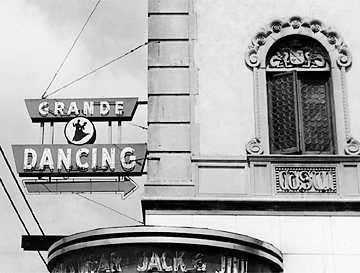 Grande Ballroom Marquee, 1950's
Grande Ballroom Marquee, 1950's Jazz Artist Sun Ra (1992)
Jazz Artist Sun Ra (1992)During this time, the Grande featured the avant garde jazz of John Coltrane and Sun Ra, who had a good and popular following and many of the patrons would return for more of this style of music over the years.
Mrs. Hayes would act like a chaperone and hostess at the Grande, even going so far as to handle introductions of various patrons to one another for impromptu "get togethers" and wholesome pairings.
It was said that she believed that teenagers of the time were more interested in learning the graceful steps associated with Ballroom Dancing, and would possibly be an asset to them in their future endeavours. She also believed that the Grande's patrons were only "mildly interested" in be-bop and Rock-n-Roll music.

The Big Band era performers on the Stage of the Grande (unknown date)
The dancers at the Grande did the fox trot, tango, waltz and bolero, as well as swing and the Charleston, and she was quoted as saying “the current favorite of our dancers is the Cha Cha Cha.”
The 1950's passed into the 1960's and by 1961, the Grande Ballroom was the only venue in the City of Detroit with any type of dance that resembled what Ballroom Dancing had once been.
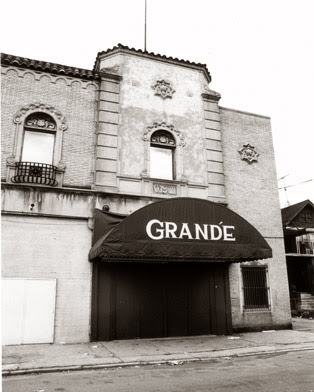 Main Entrance, possibly 1976
Main Entrance, possibly 1976
Unfortunately, this type of attitude was also what led to the Grande's demise as a dance hall. It would close to dancing in the early 1960's to soon become a roller-skating rink and then later-on be used as a storage warehouse for furniture.
 1928 (L) and 2010 (R)
1928 (L) and 2010 (R)

The above montage is a collection of Russ Gibb memories that are some of the most noted items in Detroit, as well as musical history. On his desk in front of him, probably his most-noted, and biggest public claim-to-fame: A dead Paul McCartney, along with his underground comic O-Zone, a vynil record for DJ Russ, and an apple and video cassette for Teacher Russ. Above him is the 25th Hour clock, Iggy Pop is on the video screen, Nellie Lutcher (who was an African-American R&B and jazz singer and pianist) looks over his shoulder as do his students. On the wall are flyers from The Grande Ballroom and band flyers from local Detroit talent he promoted. Felix The Cat, the mascot of his classroom, watches over him.
"Uncle" Russ Gibb (born 1931) is a former concert promoter, and media personality from Dearborn, Michigan, probably most famous for his role in the Paul is Dead phenomenon, a story he broke as a DJ on WKNR-FM. Prior to this, he went out to Calfornia to visit a friend and attended a concert by "The Byrds" at the popular Fillmore Auditorium in San Francisco.

Russ Gibb, 1960's
When he returned to the Motor City, he had a mission. That mission was to try to bring the essence of the Fillmore to Motown and that mission began with scouting some of the local venues to see what would work to accomplish this. He checked several places and finally settled on the Grande, which was near where Russ had grown-up in the 1940's, and he entered into an agreement to manage. He made an agreement with the Kleinman family to be able to rent-to-buy the Grande, and the mission of bringing new life to the Grande began to take-shape. Other DJ's were asked if they wanted to kick-in on the deal. The response was relatively negative, citing that it was a less-than-desirable neighborhood and that they wholeheartedly believed that it would fail miserably.
 The first Grande Ballroom poster for the MC5’s debut appearance
The first Grande Ballroom poster for the MC5’s debut appearanceat the venue, designed by Gary Grimshaw, November 1966.
Gibb reached out to the "beatniks" and counter-culture population and worked closely with Detroit counterculture figure and founding member of the MC5 (Motor City Five), John Sinclair, and other counter-culture groups of the time. Gibb would also mold the Grande after popular rock halls on the West Coast like the Fillmore and Whiskey A Go-Go.
A massive screen hung behind the stage at the Grande showing light shows and psychedelic water and oil images. The MC5 wound up being like the anchor of the Grande, playing there every week at least once. The band’s lead singer, Rob Tyner, introduced Gibb to his friend Gary Grimshaw, who would go on to become a legendary graphic artist, made its concert posters and handbills to promote the shows.

Grand Opening 1966 Some of the posters for the Grande that included Cream, Yardbirds, The Who, Big Brother Holding Company, just to name a few.
Some of the posters for the Grande that included Cream, Yardbirds, The Who, Big Brother Holding Company, just to name a few. MC5, Charlie Auringer, 1971
MC5, Charlie Auringer, 1971 MC5, Charlie Auringer, 1971, Grande
MC5, Charlie Auringer, 1971, Grande Janis Joplin and Big Brother, Grande Ballroom, Detroit 1968.
Janis Joplin and Big Brother, Grande Ballroom, Detroit 1968. Jeff Beck Group, Charlie Auringer, 1969
Jeff Beck Group, Charlie Auringer, 1969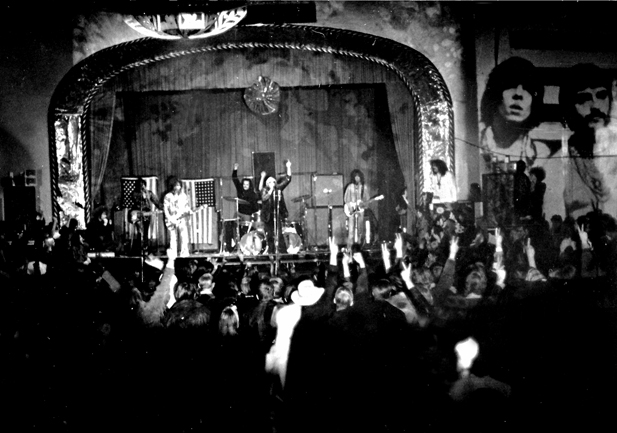
In 1967 Cream played the Grande for two nights and one afternoon in October. Pink Floyd, opening for the Who, at the Grande in 1968
Pink Floyd, opening for the Who, at the Grande in 1968 The Who at the Grande | 1968
The Who at the Grande | 1968 Fleetwood Mac at the Grande | 1968
Fleetwood Mac at the Grande | 1968wm.jpg) Concert Poster for Fleetwood Mac, Pink Floyd, and The Who's July 13th, 1968 show.
Concert Poster for Fleetwood Mac, Pink Floyd, and The Who's July 13th, 1968 show. MC5 at the Grande Ballroom 10/30/1968
MC5 at the Grande Ballroom 10/30/1968
1972 arrived and Russ Gibb began booking shows at bigger venues, including the Michigan Theatre (which had then become the Michigan Palace in Downtown Detroit) and also other cities in the Midwest. Gibb was dealing mainly with the agents for many of the bands and wanted to mainly have local bands play, but the deals would include other bands that weren't so well-known and didn't attract the crowds to the Grande as they once had. Like any good business, the income has to be there to be able to keep the business afloat and the Grande just wasn't making the money that it had even a few short years earlier. The decision was made to focus on the bigger, more profitable venues and not so much the Grande Ballroom.
Russ Gibb was quoted as saying "I could do bigger shows with less hassle elsewhere. The scene was changing, and if you’re going to do anything right, you’ve got to be on the crest of change." The change... would mean the end of the almost-constant stream of acts and patrons to the Grande and it's architecturally beautiful decor.
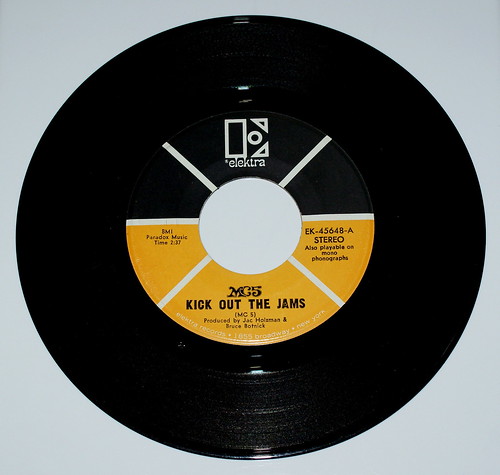 MC5's 'Kick out the Jams' vinyl 45
MC5's 'Kick out the Jams' vinyl 45
After the venue was closed, the building was hardly used and the neighborhood surrounding it began to show the signs of neglect. A resale shop moved-in for a time, but even that eventually disappeared as well, leaving the building empty and unoccupied.

Main Door, 1970's A very pixeled & fuzzy logo for the Westland Grande Ballroom, a "teen club" from 1986-1990
A very pixeled & fuzzy logo for the Westland Grande Ballroom, a "teen club" from 1986-1990
This didn't last too long and the Grande name disappeared from the landscape of Metro Detroit, but not the hearts, minds, and memories of those that remember.
 2003 view of the Grande outside
2003 view of the Grande outside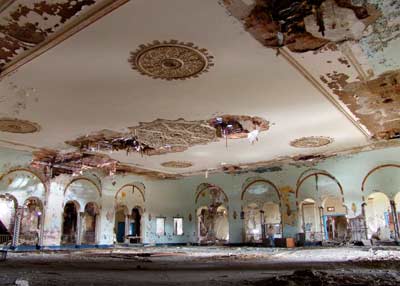 2003 view of the main floor and ceiling.
2003 view of the main floor and ceiling. Some of the detail that was present in the Grande (2010)
Some of the detail that was present in the Grande (2010)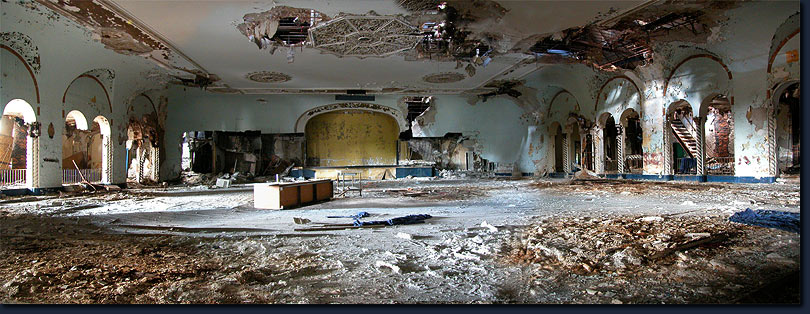 Panorama of the Grande's main dance floor (2010)
Panorama of the Grande's main dance floor (2010)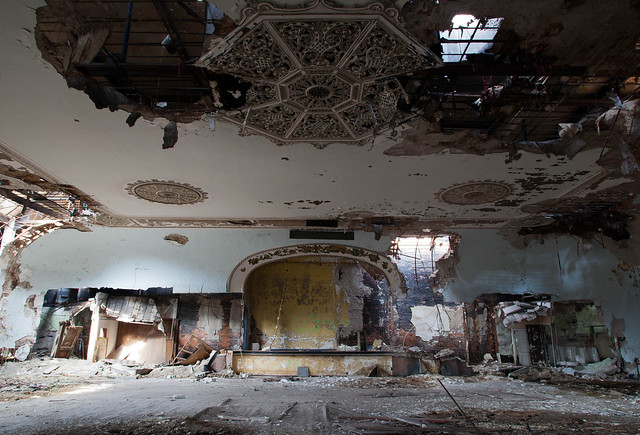
March 2012 view of the slow decay of the Grande compared to 2010.
The Grande Ballroom, along with many other abandoned places, has been the subject and destination of many "urban explorers" over the years. There are reports and stories of hearing voices, or rock-n-roll music playing (not the kind of music from passing traffic, of course) but nothing has been confirmed or investigated further. Many folks have attributed this to "the paranormal" as the Grande is and was a beloved place to visit. Some have just dismissed it as "unusual sounds" but nothing "worth looking-into more"....at least not yet. Maybe these sounds are just echoes of the past...the wondrous musical past that rocked these walls and was full of so much energy.
The Puzzle: N 42° AB.CDE W 083° ZY.XWV
A: Number of Ballrooms Designed by Charles Agree (in this write-up)
B: Fourth Digit of the year Russ Gibb was born
C: Last Digit of the Year the Grande Ballroom opened.
D: Ticket prices that would allow you to see four bands were only __(D)__ dollars.
E: Add ONE to the Third Digit of the year of the Summer Of Love
Z: Second Digit of the year the Ownership changed from one church to another.
Y: Third Digit of the year the Grande finally Closed.
X: Fourth Digit of the year there was an article in the Detroit News.
W: Total children of the original owner, subtracted by the number of days Led Zeppelin played consecutively.
V: The Who, Pink Floyd, and Fleetwood Mac played the Grande in 1968. Take the first and second digit of the day together, then add THREE to this total to get "V"
To validate your solution, you may check your work below: